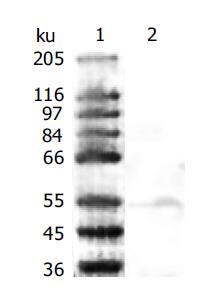Copyright
©2005 Baishideng Publishing Group Inc.
World J Gastroenterol. Apr 21, 2005; 11(15): 2260-2263
Published online Apr 21, 2005. doi: 10.3748/wjg.v11.i15.2260
Published online Apr 21, 2005. doi: 10.3748/wjg.v11.i15.2260
Figure 1 Eight grams per liter agarose gel electrophoreses of AlpA DNA fragment amplified by PCR from H pylori.
Lane 1: PCR products; Lane 2: nucleotide marker.
Figure 2 Identification of recombinant plasmid by restriction enzyme digestion.
Lane 1: Nucleotide marker; lane 2: PCR products; lane 3: pET22b(+)/Not I; lane 4: recombinant plasmid/Not I; lane 5: recombinant plasmid/Not I and Nco I.
Figure 3 SDS-PAGE analysis of 100 g/L fusion protein expressed in BL21(DE3).
Lane 1: Molecular weight marker (20, 30, 43, 67, 94)×103; lane 2: BL21 (pET-AlpA) cells before induction; lane 3: BL21 (pET-AlpA) cells in periplasm protein after 3-h induction with IPTG; lane 4: BL21 (pET-AlpA) cells after 3-h induction with IPTG; lane 5: BL21 (pET-AlpA) cells after 5-h induction with IPTG; lane 6: sonicated supernatant of BL21 (pET-AlpA) cells after 3-h induction with IPTG; lane 7: inclusion body of BL21 (pET-AlpA) cells after 3-h induction with IPTG; lane 8: control strain BL21 (pET) before induction; lane 9: control strain BL21 (pET) after 3-h induction with IPTG.
Figure 4 Western blot analysis of AlpA recombinant protein.
Lane 1: protein marker; lane 2: AlpA immunogenicity detected using polyclonal rabbit antiserum.
-
Citation: Xue J, Bai Y, Chen Y, Wang JD, Zhang ZS, Zhang YL, Zhou DY. Expression of
Helicobacter pylori AlpA protein and its immunogenicity. World J Gastroenterol 2005; 11(15): 2260-2263 - URL: https://www.wjgnet.com/1007-9327/full/v11/i15/2260.htm
- DOI: https://dx.doi.org/10.3748/wjg.v11.i15.2260












